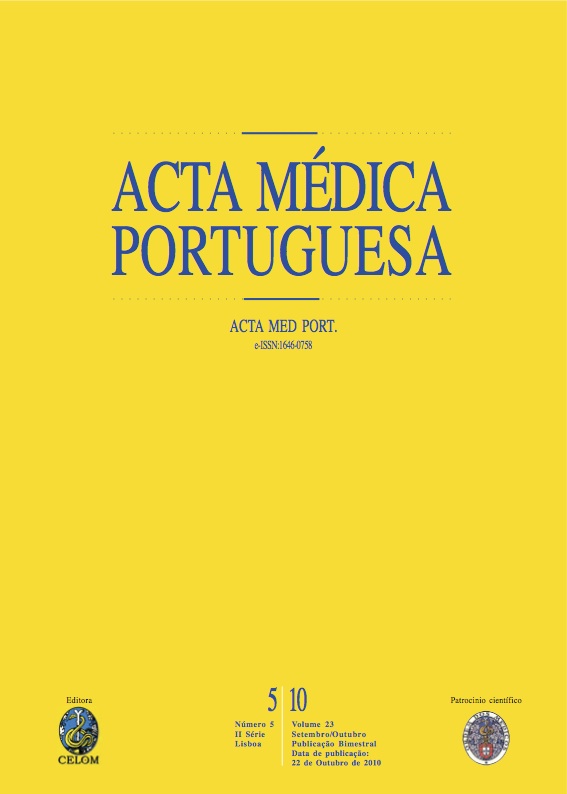Eating disorders in adolescents - what to look for?.
DOI:
https://doi.org/10.20344/amp.726Abstract
Increase in the incidence and prevalence of Eating Disorders have made it increasingly important that Health Care Professionals be familiar with the early detection and appropriate management of this group of disorders.To characterize an adolescent population followed in Adolescent Medicine office visit of Pediatric Department in Leiria's Hospital with Eating Disorders for type of disorder, presence of alert signs and symptoms and risk factors for an early detection of disease.Retrospective analytic study conducted by consulting clinical processes and first office visit questionnaires of adolescent population followed for Eating Disorders, between August 2005 and April 2008. Criteria of Diagnostic and Statistical Manual of Mental Disorders - Fourth Edition were considered to define Eating Disorder type.Twenty two adolescents were included, with 20 girls. Five adolescents met all Anorexia Nervosa criteria and two met all Bulimia Nervosa criteria. The other 15 were included in Eating Disorder Not Otherwise Specified. All samples showed intense fear of gaining weight and 20 adolescents a disturbed body image. All adolescents confessed having restrictive eating attitudes, half had compensatory behaviors and four assume having recurrent episodes of binge eating. Almost all revealed some type of somatic complaint and 19 showed psychological symptoms. One third of this population had personal history of obesity/overweight. Most adolescents presented weight lost when observed in the first office visit. Six adolescents showed body weight under 85% of that expected. One third of postmenarche adolescents suffered from secondary amenorrhea. Half of adolescents reported dysfunctional family and one quarter had separate parents; eight adolescents had family history of mental illness.Most adolescents were included in the diagnosis of Eating Disorder Not Otherwise Specified, according with other studies in this age. This fact implies that in practice the suspicion of an Eating Disorder in an adolescent should not be restricted to the meeting of other categories criteria. For an early detection, relevance should be given to aspects like a weight loss even without an abnormal body mass index, an inappropriate eating attitude, a dissatisfaction with body image, associated with a multiplicity of psychosomatic complaints, in a dysfunctional family environment.Downloads
Downloads
How to Cite
Issue
Section
License
All the articles published in the AMP are open access and comply with the requirements of funding agencies or academic institutions. The AMP is governed by the terms of the Creative Commons ‘Attribution – Non-Commercial Use - (CC-BY-NC)’ license, regarding the use by third parties.
It is the author’s responsibility to obtain approval for the reproduction of figures, tables, etc. from other publications.
Upon acceptance of an article for publication, the authors will be asked to complete the ICMJE “Copyright Liability and Copyright Sharing Statement “(http://www.actamedicaportuguesa.com/info/AMP-NormasPublicacao.pdf) and the “Declaration of Potential Conflicts of Interest” (http:// www.icmje.org/conflicts-of-interest). An e-mail will be sent to the corresponding author to acknowledge receipt of the manuscript.
After publication, the authors are authorised to make their articles available in repositories of their institutions of origin, as long as they always mention where they were published and according to the Creative Commons license.









